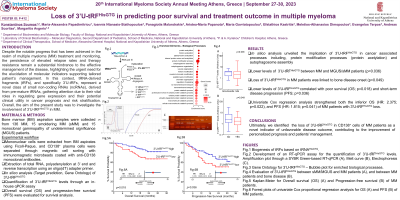Myeloma Microenvironment and immune profiling
Poster Session 3
P-412: Loss of 3’U-tRFHisGTG in predicting poor survival and treatment outcome in multiple myeloma
Friday, September 29, 2023
1:15 PM - 2:15 PM EEST


Konstantinos Soureas, MSc (he/him/his)
Scientific associate
National and Kapodistrian University of Athens, United States
Introduction: Despite the notable progress that has been achieved in the realm of multiple myeloma (MM) treatment and monitoring, the persistence of elevated relapse rates and therapy resistance remain a substantial hindrance to the effective management of the disease, highlighting the urgent need for the elucidation of molecular indicators supporting tailored patient’s management. In this context, tRNA-derived fragments (tRFs), and specifically 3’U-tRFs, represent a novel class of small non-coding RNAs (ncRNAs), derived from pre-mature tRNAs, gathering attention due to their vital roles in regulating gene expression and their potential clinical utility in cancer prognosis and risk stratification. Overall, the aim of the present study was to investigate the involvement of 3’U-tRFHisGTG in MM.
Methods: Bone marrow aspiration (BMA) samples were collected from 136 MM, 15 smoldering MM (sMM) and 15 monoclonal gammopathy of undetermined significance (MGUS) patients at diagnosis. Mononuclear cells were extracted from BM aspirates using Ficoll-Paque, and CD138+ plasma cells were separated through magnetic cell sorting, using immunomagnetic beads coated with anti-CD138 monoclonal antibodies. Based on target prediction and Gene Ontology (GO) enrichment, 3’U-tRFHisGTG was further evaluated for the first time in CD138+ plasma cells from the total study population. Following, total RNA extraction, polyadenylation at 3’-end, and reverse transcription using an oligo(dT) adapter primer, 3’U-tRFHisGTG levels were estimated through in-house qPCR. Finally, overall survival (OS) and progression-free survival (PFS) were evaluated, while internal validation was accomplished by bootstrap Cox proportional regression analysis.
Results: In silico analysis unveiled the implication of 3’U-tRFHisGTG in cancer associated processes including, protein modification processes (protein acetylation), and autophagosome assembly. Our findings demonstrated the downregulated 3’U-tRFHisGTG levels in MM compared to its precursor stages sMM/MGUS (p=0.036), while focusing on MM patients, 3’U-tRFHisGTG loss depicted the association with bone disease (p=0.049). Furthermore, survival analysis revealed that loss of 3’U-tRFHisGTG was associated with significantly poor overall survival following treatment (p=0.018) and higher risk for short-term disease progression (p=0.036). Additionally, univariate Cox regression analysis strengthened both the inferior OS (HR: 2.375; p=0.022), and PFS (HR: 1.815; p=0.041) of MM patients with 3’U-tRFHisGTG loss.
Conclusions: 3’U-tRFHisGTG loss in CD138+ cells of MM patients represent a novel molecular marker of unfavourable outcome, contributing to the improvement of personalized prognosis and patients’ management.
Methods: Bone marrow aspiration (BMA) samples were collected from 136 MM, 15 smoldering MM (sMM) and 15 monoclonal gammopathy of undetermined significance (MGUS) patients at diagnosis. Mononuclear cells were extracted from BM aspirates using Ficoll-Paque, and CD138+ plasma cells were separated through magnetic cell sorting, using immunomagnetic beads coated with anti-CD138 monoclonal antibodies. Based on target prediction and Gene Ontology (GO) enrichment, 3’U-tRFHisGTG was further evaluated for the first time in CD138+ plasma cells from the total study population. Following, total RNA extraction, polyadenylation at 3’-end, and reverse transcription using an oligo(dT) adapter primer, 3’U-tRFHisGTG levels were estimated through in-house qPCR. Finally, overall survival (OS) and progression-free survival (PFS) were evaluated, while internal validation was accomplished by bootstrap Cox proportional regression analysis.
Results: In silico analysis unveiled the implication of 3’U-tRFHisGTG in cancer associated processes including, protein modification processes (protein acetylation), and autophagosome assembly. Our findings demonstrated the downregulated 3’U-tRFHisGTG levels in MM compared to its precursor stages sMM/MGUS (p=0.036), while focusing on MM patients, 3’U-tRFHisGTG loss depicted the association with bone disease (p=0.049). Furthermore, survival analysis revealed that loss of 3’U-tRFHisGTG was associated with significantly poor overall survival following treatment (p=0.018) and higher risk for short-term disease progression (p=0.036). Additionally, univariate Cox regression analysis strengthened both the inferior OS (HR: 2.375; p=0.022), and PFS (HR: 1.815; p=0.041) of MM patients with 3’U-tRFHisGTG loss.
Conclusions: 3’U-tRFHisGTG loss in CD138+ cells of MM patients represent a novel molecular marker of unfavourable outcome, contributing to the improvement of personalized prognosis and patients’ management.
